Disentangling Values in the Interrelations between Cultural Ecosystem Services and Landscape Conservation—A Case Study of the Ifugao Rice Terraces in the Philippines
Abstract
:1. Introduction
2. Theoretical Background: Relevance of Cultural Ecosystem Services and Progress of Cultural Ecosystem Service Studies
3. Material and Methods
3.1. Study Site
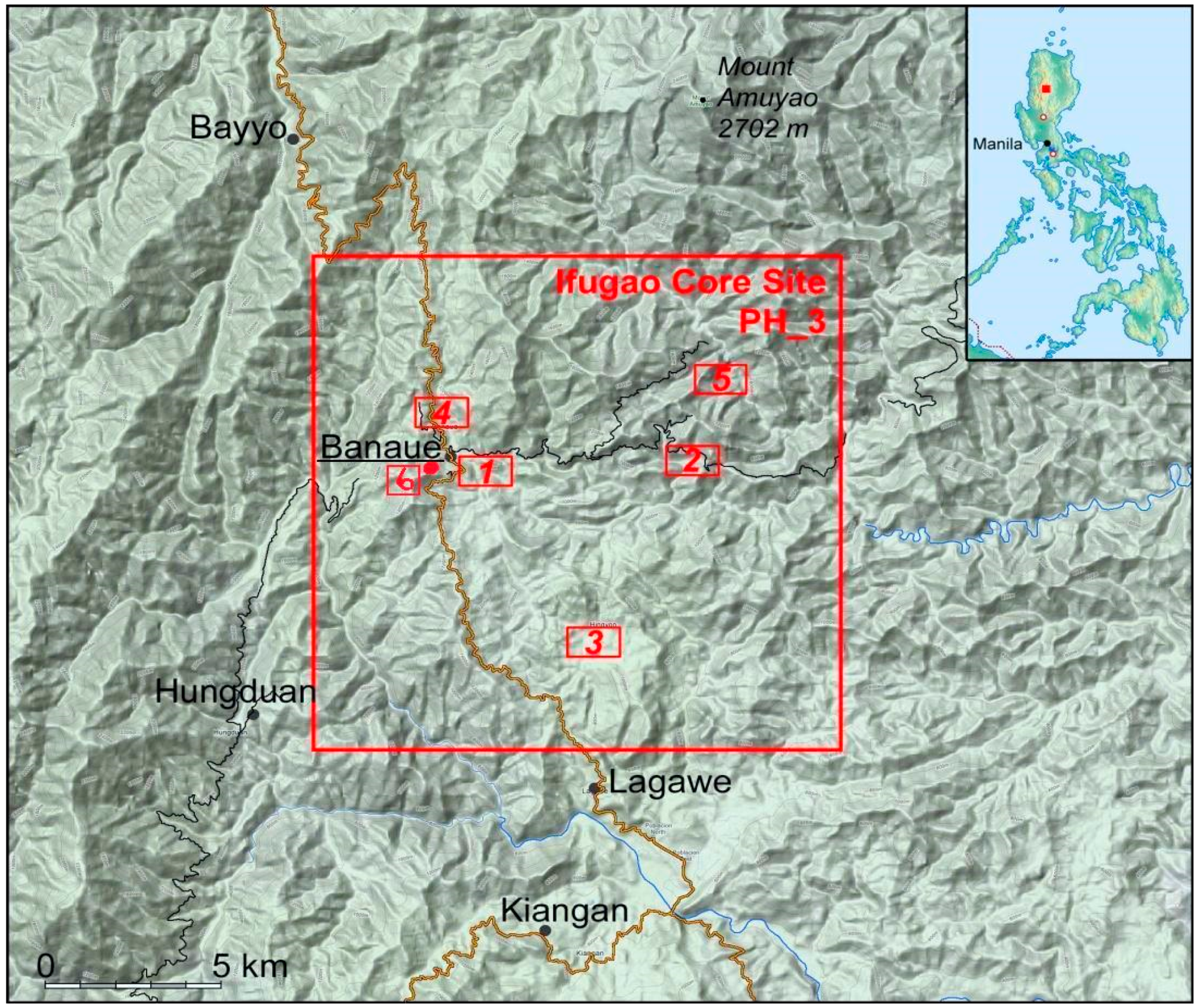
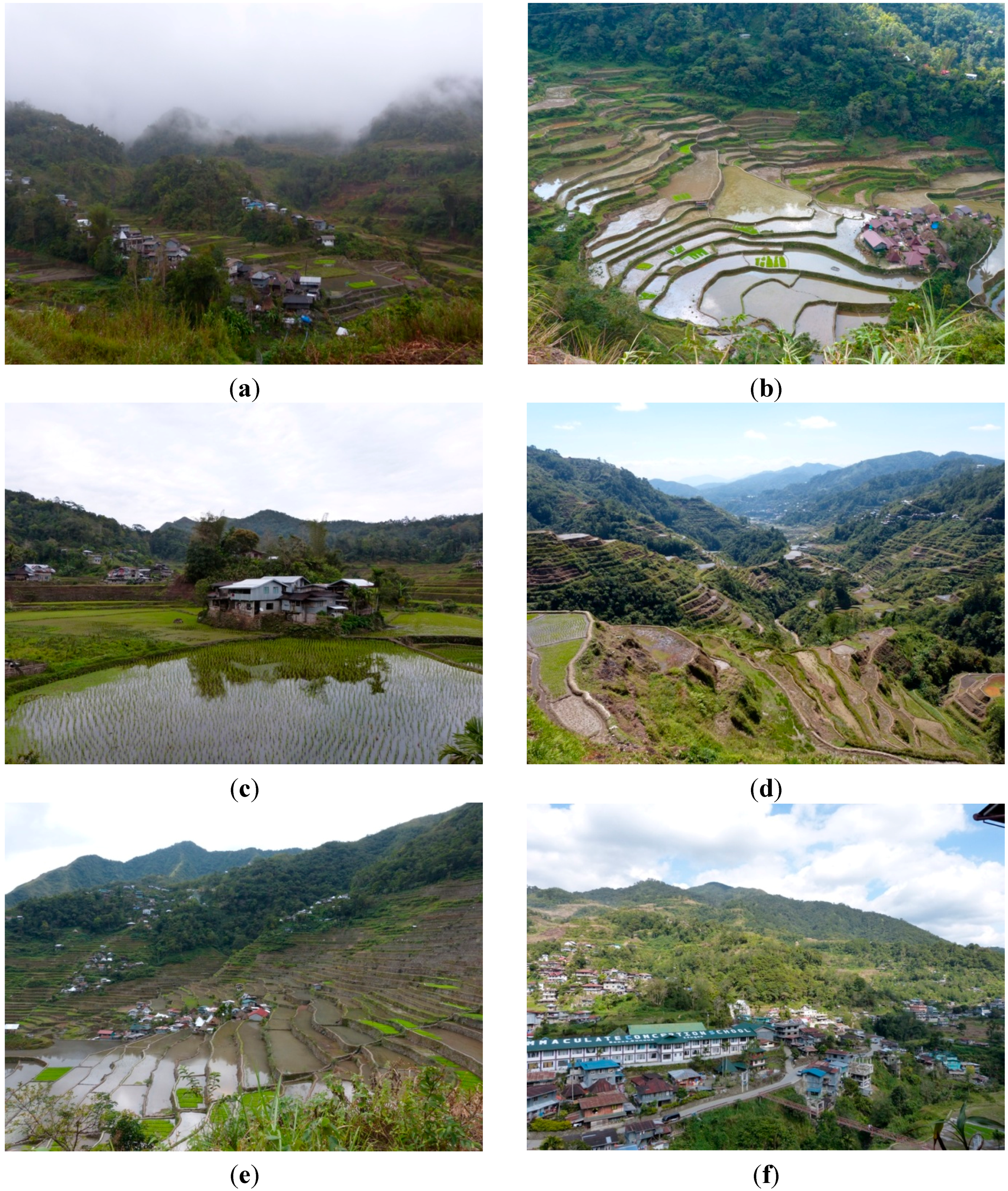
3.2. Methodology

3.2.1. Selection of the Study Site(s)
3.2.2. Definitions
- Recreation relates to people’s decision about where to spend their free time based on the characteristics of a landscape in a particular area.
- Spiritual values are sacred, religious, or other forms of spiritual inspiration attached to ecosystems.
- Aesthetic values represent the beauty that people see in various aspects of an ecosystem.
- Knowledge systems consist in the traditional and formal knowledge different cultures developed over time influenced by the ecosystems.
- Cultural heritage values (or simply ‘heritage’) stand for the value that societies place on the maintenance of historically important landscapes. In its tangible form, cultural heritage can be physical historical objects and places that have been passed on from generation to generation. In its intangible form it includes languages and traditions.
- Cultural identity is related to the attachment to home, values, norms and a certain lifestyle. It develops from people’s collective roots.
3.2.3. Data Collection
Semi-Structured Interviews
Likert Scale Questionnaire
3.2.4. Data Analysis
Qualitative Data Analysis
Quantitative Data Analysis
4. Results
4.1. Reasons for and Implications of the Degradation of the Rice Terraces
| Statement (Q1–Q10: Causes of Degradation, Q11–Q20: Implications of Future Degradation) | Strongly Agree | Agree | Undecided | Disagree | Strongly Disagree | Category of Analysis 1 |
|---|---|---|---|---|---|---|
| Q1. Farmers have been abandoning the fields to work in tourism | 8%2 | 39% 2 | 12% | 35% | 6% | Recreation (CES) |
| Q2. Agricultural work is no longer profitable | 8% | 50% | 11% | 23% | 9% | Economy (SE) |
| Q3. More migration to other cities | 14% | 62% | 8% | 15% | 2% | Migration (SE) |
| Q4. The young gen. has higher education and doesn’t want to work in agriculture | 20% | 52% | 8% | 20% | 2% | Knowledge systems (CES) |
| Q5. The young gen. doesn’t have the same skills to cultivate the terraces than the older gen. | 14% | 63% | 2% | 20% | 2% | Cultural heritage (CES) |
| Q6. The young gen. doesn’t want to work in agriculture anymore because other work has a higher status and is better seen | 18% | 52% | 12% | 17% | 2% | Cultural identity (CES) |
| Q7. There is not enough water due to irrigation or due to other problems | 8% | 58% | 11% | 20% | 5% | ENV |
| Q8. The climate has been changing and does not provide optimal conditions to sustain the terraces anymore | 8% | 52% | 17% | 21% | 3% | ENV |
| Q9. Because the soil has been losing its fertility | 5% | 24% | 11% | 55% | 6% | ENV |
| Q10. Because of landslides destroying the terraces | 12% | 73% | 6% | 8% | 0% | ENV |
| Q11. The number of visitors will decline | 29% | 55% | 14% | 3% | 0% | Recreation (CES) |
| Q12. The income from visitors will decline | 17% | 73% | 6% | 5% | 0% | Recreation (CES) |
| Q13. Visitors will be more satisfied with their visit | 3% | 8% | 12% | 71% | 6% | Recreation (CES) |
| Q14. The overall quality of the recreational experience will decline | 5% | 70% | 19% | 5% | 2% | Recreation (CES) |
| Q15. The crop production of the communities will be threatened | 6% | 82% | 8% | 5% | 0% | Economy (SE) |
| Q16. The landscape scenery of the region will be less beautiful | 11% | 77% | 5% | 6% | 2% | Aesthetics (CES) |
| Q17. Spiritual values will get more & more lost | 9% | 39% | 22% | 27% | 3% | Spiritual values (CES) |
| Q18. The practice of rituals will not decrease, but maintained | 3% | 30% | 15% | 48% | 3% | Cultural heritage (CES) |
| Q19. The number of people with traditional agricultural knowledge will decrease | 5% | 62% | 15% | 17% | 2% | Knowledge systems (CES) |
| Q20. The current trends in the tourism activities will remain the same. It does not depend on the state of terraces | 0% | 11% | 27% | 56% | 6% | Recreation (CES) |
4.2. Interrelations and Tradeoffs between the State of the Landscape and Different CES
4.2.1. Cultural Identity and Heritage Values
4.2.2. Aesthetics, Spiritual Values and Knowledge Systems
4.2.3. Recreation
4.3 Interrelations and Tradeoffs between Different CES
4.3.1. Interrelations Gained from the Correlation Test
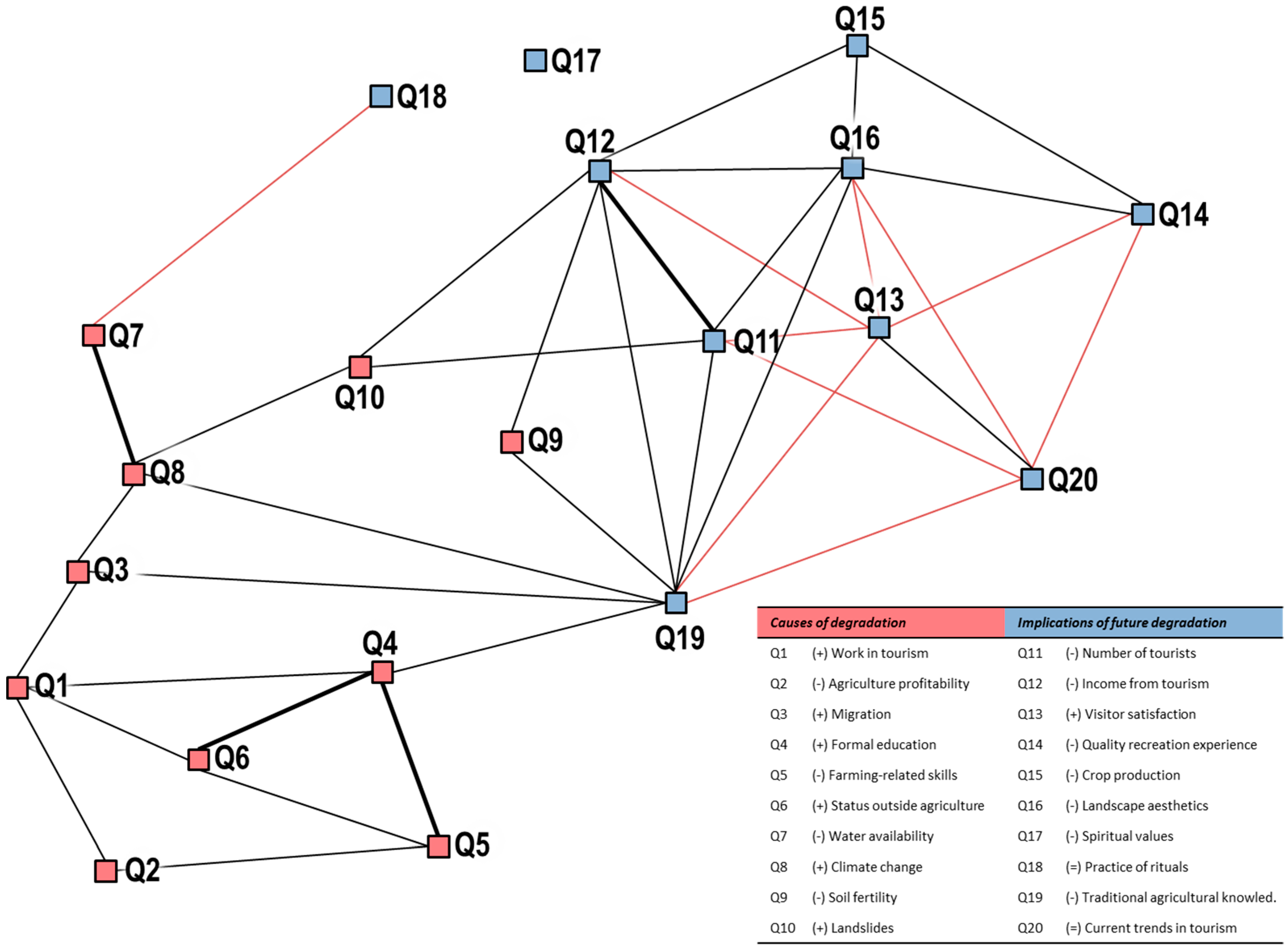

4.3.2. Interrelations and Tradeoffs Identified and Analysed from the Interviews
5. Discussion
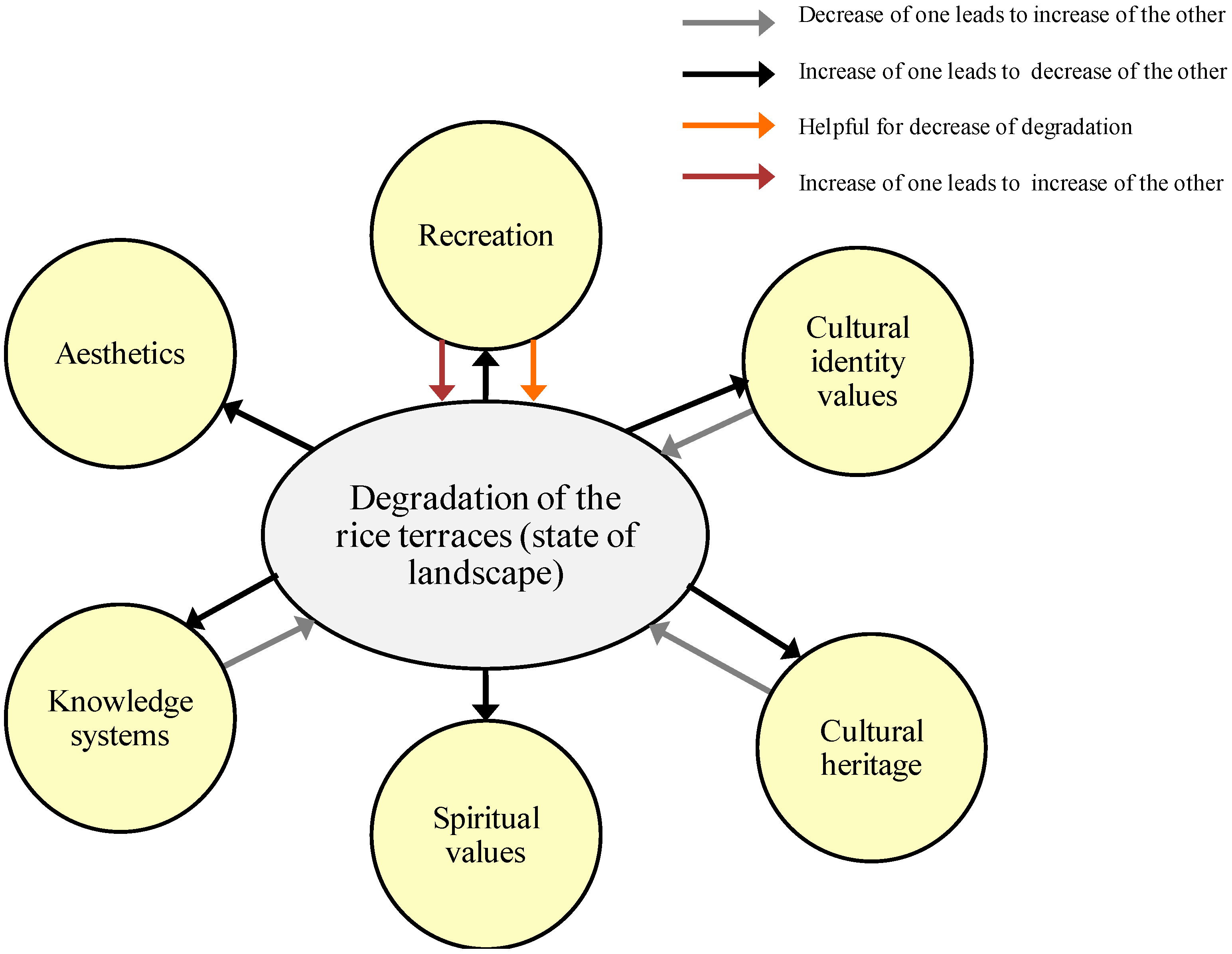
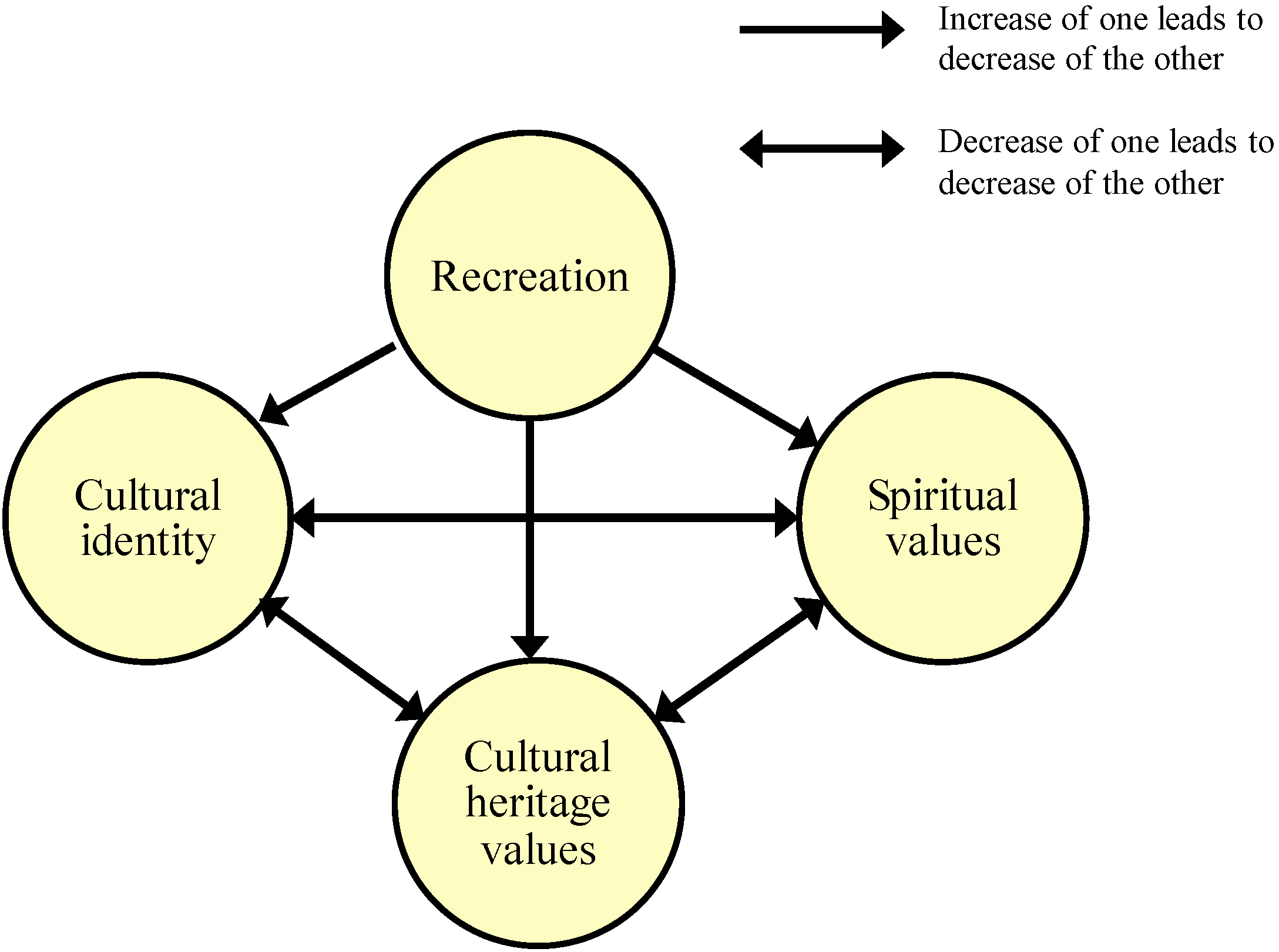
6. Conclusion
Supplementary Files
Supplementary File 1Acknowledgments
Author Contributions
Conflicts of Interest
References
- Dominati, E.; Mackay, A. An Ecosystem Services Approach to the Cost of Soil Erosion and Value of Soil Conservation; AgResearch Ltd., Grasslands Research Centre: Palmerston North, New Zealand, 2013. [Google Scholar]
- Sandhu, H.S.; Wratten, S.D.; Cullen, R.; Case, B. The future of farming: The value of ecosystem services in conventional and organic arable land. An experimental approach. Ecol. Econ. 2008, 64, 835–848. [Google Scholar] [CrossRef]
- Zhang, W.; Ricketts, T.H.; Kremen, C.; Carney, K.; Swinton, S.M. Ecosystem services and dis-services to agriculture. Ecol. Econ. 2007, 64, 253–260. [Google Scholar] [CrossRef]
- Ibarra, A.A.; Zambrano, L.; Valiente, E.L.; Ramos-Bueno, A. Enhancing the potential value of environmental services in urban wetlands: An agro-ecosystem approach. Cities 2013, 31, 438–443. [Google Scholar] [CrossRef]
- Swinton, S.M.; Lupi, F.; Robertson, G.P.; Hamilton, S.K. Ecosystem services and agriculture: Cultivating agricultural ecosystems for diverse benefits. Ecol. Econ. 2007, 64, 245–252. [Google Scholar] [CrossRef]
- Calvet-Mir, L.; Gómez-Baggethun, E.; Reyes-García, V. Beyond food production: Ecosystem services provided by home gardens. A case study in Vall Fosca, Catalan Pyrenees, Northeastern Spain. Ecol. Econ. 2012. [Google Scholar] [CrossRef]
- Barrena, J.; Nahuelhual, L.; Báez, A.; Schiappacasse, I.; Cerda, C. Valuing cultural ecosystem services: Agricultural heritage in Chiloé Island, Southern Chile. Ecosyst. Serv. 2014, 7, 66–75. [Google Scholar] [CrossRef]
- Schaich, H.; Biding, C.; Plieninger, T. Linking ecosystem services with cultural landscape research. GAIA 2010, 19, 269–277. [Google Scholar]
- Tengberg, A.; Fredholm, S.; Eliasson, I.; Knez, I.; Saltzman, K.; Wetterberg, O. Cultural ecosystem services provided by landscapes: Assessment of heritage values and identity. Ecosyst. Serv. 2012, 2, 14–26. [Google Scholar] [CrossRef]
- UNESCO. Impact: The Effects of Tourism on Culture and the Environment in Asia and the Pacific: Sustainable Tourism and the Preservation of the World Heritage Site of the Ifugao Rice Terraces, Philippines; UNESCO: Bangkok, Thailand, 2008. [Google Scholar]
- Conklin, H.C. Ifugao Ethnobotany 1905–1965: The 1911 Beyer-Merrill Report in perspective. Econ. Bot. 1967, 21, 243–272. [Google Scholar] [CrossRef]
- Conklin, I.C.; Ng, J.; Ye, N. Harold C. Conklin Philippine Collection; AFC 2001/007; Archive of Folk Culture, American Folklife Center, Library of Congress: Washington, DC, USA, 2010.
- Brosius, J.P. Significance and social being in Ifugao agricultural production. Ethnology 1988, 27, 97–110. [Google Scholar] [CrossRef]
- Acabado, S. The Ifugao agricultural landscapes: Agro-cultural complexes and the intensification debate. J. Southeast Asian Stud. 2012, 43, 500–522. [Google Scholar] [CrossRef]
- Araral, E. What makes socio-ecological systems robust? An institutional analysis of the 2,000 year-old Ifugao society. Hum. Ecol. 2013, 41, 859–870. [Google Scholar] [CrossRef]
- Costanza, R.; Kubiszewski, I. The authorship structure of “ecosystem services” as a transdisciplinary field of scholarship. Ecosyst. Serv. 2012, 1, 16–25. [Google Scholar] [CrossRef]
- Seppelt, R.; Dormann, C.F.; Eppink, F.V.; Lautenbach, S.; Schmidt, S. A quantitative review of ecosystem service studies: approaches, shortcomings and the road ahead. J. Appl. Ecol. 2011, 48, 630–636. [Google Scholar] [CrossRef]
- Sandhu, H.S.; Wratten, S.D.; Cullen, R. Organic agriculture and ecosystem services. Environ. Sci. Policy 2010, 13, 1–7. [Google Scholar] [CrossRef]
- Johnson, K.A.; Polasky, S.; Nelson, E.; Pennington, D. Uncertainty in ecosystem services valuation and implications for assessing land use tradeoffs: An agricultural case study in the Minnesota River Basin. Ecol. Econ. 2012, 79, 71–79. [Google Scholar] [CrossRef]
- Chan, K.M.A.; Satterfield, T.; Goldstein, J. Rethinking ecosystem services to better address and navigate cultural values. Ecol. Econ. 2012, 74, 8–18. [Google Scholar] [CrossRef]
- Millenium Ecosystem Assessment; Island Press: Washington, DC, USA, 2005.
- Daniel, T.C.; Muhar, A.; Arnberger, A.; Aznar, O.; Boyd, J.W.; Chan, K.M.A.; Costanza, R.; Elmqvist, T.; Flint, C.G.; Gobster, P.H.; et al. Contributions of cultural services to the ecosystem services agenda. Proc. Natl. Acad. Sci. USA 2012, 109, 8812–8819. [Google Scholar] [CrossRef] [PubMed]
- Hernández-Morcillo, M.; Plieninger, T.; Bieling, C. An empirical review of cultural ecosystem service indicators. Ecol. Indic. 2013, 29, 434–444. [Google Scholar] [CrossRef]
- Plieninger, T.; Dijks, S.; Oteros-Rozas, E.; Bieling, C. Assessing, mapping, and quantifying cultural ecosystem services at community level. Land Use Policy 2013, 33, 118–129. [Google Scholar] [CrossRef]
- Milcu, A.I.; Hanspach, J.; Abson, D.; Fischer, J. Cultural ecosystem services: A literature review and prospects for future research. Ecol. Soc. 2013. [Google Scholar] [CrossRef]
- Nahuelhual, L.; Carmona, A.; Laterra, P.; Barrena, J.; Aguayo, M. A mapping approach to assess intangible cultural ecosystem services: The case of agriculture heritage in Southern Chile. Ecol. Indic. 2014, 40, 90–101. [Google Scholar] [CrossRef]
- Van den Belt, M.; Blake, D. Ecosystem services in New Zealand agro-ecosystems: A literature review. Ecosyst. Serv. 2014, 9, 115–132. [Google Scholar] [CrossRef]
- Peña, L.; Casado-Arzuaga, I.; Onaindia, M. Mapping recreation supply and demand using an ecological and a social evaluation approach. Ecosyst. Serv. 2015, 13, 108–118. [Google Scholar] [CrossRef]
- Van Berkel, D.B.; Verburg, P.H. Spatial quantification and valuation of cultural ecosystem services in an agricultural landscape. Ecol. Indic. 2014, 37, 163–174. [Google Scholar] [CrossRef]
- Martín-López, B.; Iniesta-Arandia, I.; García-Llorente, M.; Palomo, I.; Casado-Arzuaga, I.; Del Amo, D.G.; Gómez-Baggethun, E.; Oteros-Rozas, E.; Palacios-Agundez, I.; Willaarts, B.; et al. Uncovering ecosystem service bundles through social preferences. PLoS One 2012. [Google Scholar] [CrossRef] [PubMed]
- Chan, K.M.A.; Guerry, A.D.; Balvanera, P.; Klain, S.; Satterfield, T.; Basurto, X.; Bostrom, A.; Chuenpagdee, R.; Gould, R.; Halpern, B.S.; et al. Where are cultural and social in ecosystem services? A framework for constructive engagement. Bioscience 2012, 62, 744–756. [Google Scholar] [CrossRef]
- Busch, M.; La Notte, A.; Laporte, V.; Erhard, M. Potentials of quantitative and qualitative approaches to assessing ecosystem services. Ecol. Indic. 2012, 21, 89–103. [Google Scholar] [CrossRef]
- Chee, Y.E. An ecological perspective on the valuation of ecosystem services. Biol. Conserv. 2004, 120, 549–565. [Google Scholar] [CrossRef]
- Wegner, G.; Pascual, U. Cost-benefit analysis in the context of ecosystem services for human well-being: A multidisciplinary critique. Glob. Environ. Chang. 2011, 21, 492–504. [Google Scholar] [CrossRef]
- Raymond, C.M.; Kenter, J.; Turner, N.; Alexander, K. Comparing instrumental and deliberative paradigms underpinning the assessment of social values for cultural ecosystem services. Ecol. Econ. 2014, 107, 145–156. [Google Scholar] [CrossRef]
- Stephenson, J. The Cultural Values Model: An integrated approach to values in landscapes. Landsc. Urban Plan. 2008, 84, 127–139. [Google Scholar] [CrossRef]
- Plieninger, T.; Bieling, C.; Fagerholm, N.; Byg, A.; Hartel, T.; Hurley, P.; López-Santiago, C.A.; Nagabhatla, N.; Oteros-Rozas, E.; Raymond, C.M.; et al. The role of cultural ecosystem services in landscape management and planning. Curr. Opin. Environ. Sustain. 2015, 14, 28–33. [Google Scholar] [CrossRef]
- Van Zanten, B.T.; Verburg, P.H.; Espinosa, M.; Gomez-y-Paloma, S.; Galimberti, G.; Kantelhardt, J.; Kapfer, M.; Lefebvre, M.; Manrique, R.; Piorr, A.; et al. European agricultural landscapes, common agricultural policy and ecosystem services: A review. Agron. Sustain. Dev. 2013, 34, 309–325. [Google Scholar] [CrossRef]
- Johns, T.; Powell, B.; Maundu, P.; Eyzaguirre, P.B. Agricultural biodiversity as a link between traditional food systems and contemporary development, social integrity and ecological health. J. Sci. Food Agric. 2013, 93, 3433–3442. [Google Scholar] [CrossRef] [PubMed]
- Limburg, K.E.; O’Neill, R.V.; Costanza, R.; Farber, S. Complex systems and valuation. Ecol. Econ. 2002, 41, 409–420. [Google Scholar] [CrossRef]
- Republic of the Philippines. National Statistical Coordination Board (NSCB) Human Development Index: 2009. Available online: http://www.nscb.gov.ph/hdi/2009/2009%20Human%20Development%20Index.pdf (accessed on 1 July 2014).
- Republic of the Philippines. National Statistics Office (NSO) Total Population by Province, City, Municipality and Barangay, as of May 1, 2010. Available online: http://www.census.gov.ph/sites/default/files/attachments/hsd/pressrelease/Cordillera Administrative Region.pdf (accessed on 1 July 2014).
- Settele, J.; Spangenberg, J.H.; Kühn, I.; Klotz, S.; Wiemers, M.; LEGATO Project Consortium. LEGATO Rice Ecosystem Services. Progress Report 2012; Helmholtz Centre for Environmental Research—UFZ & Pensoft: Leipzig and Halle & Sofia, Germany, 2012. [Google Scholar]
- Acabado, S. A Bayesian approach to dating agricultural terraces : A case from the Philippines. Antiquity 2009, 83, 801–814. [Google Scholar] [CrossRef]
- Department of Environment and Natural Resources (DENR). The Ifugao Rice Terraces Philippine Project Framework; FAO: Bangkok, Thailand, 2008. [Google Scholar]
- Millennium Ecosystem Assessment (MA). Ecosystems and Human Well-being: Synthesis (Millennium Ecosystem Assessment); Millenium Assessments; World Resources Institute: Washington, DC, USA, 2005; Volume 5. [Google Scholar]
- Tekken, V. Cultural Identiy & Aesthetics: The socio-cultural dimension. In Proceedings of LEGATO—Status Conference and Workshop, Banaue/Ifugao, Philippines, 4 July 2012; p. 17.
- Dick, J.M.; Smith, R.I.; Scott, E.M. Ecosystem services and associated concepts. Environmetrics 2011, 22, 598–607. [Google Scholar] [CrossRef]
- Fisher, B.; Turner, R.K. Ecosystem services: Classification for valuation. Biol. Conserv. 2008, 141, 1167–1169. [Google Scholar] [CrossRef]
- Nahlik, A.M.; Kentula, M.E.; Fennessy, M.S.; Landers, D.H. Where is the consensus? A proposed foundation for moving ecosystem service concepts into practice. Ecol. Econ. 2012, 77, 27–35. [Google Scholar] [CrossRef]
- Rova, S.; Pranovi, F.; Mueller, F. Provision of ecosystem services in the lagoon of Venice (Italy): An initial spatial assessment. Ecohydrol. Hydrobiol. 2015, 15, 13–25. [Google Scholar] [CrossRef]
- Hsieh, H.-L.; Lin, H.-J.; Shih, S.-S.; Chen, C.-P. Ecosystem functions connecting contributions from ecosystem services to human wellbeing in a mangrove system in Northern Taiwan. Int. J. Environ. Res. Public Health 2009, 12, 6542–6560. [Google Scholar] [CrossRef] [PubMed]
- Folke, C. Resilience: The emergence of a perspective for social-ecological systems analyses. Glob. Environ. Chang. 2006, 16, 253–267. [Google Scholar] [CrossRef]
- Reyes-Garcia, V.; Aceituno-Mata, L.; Calvet-Mir, L.; Garnatje, T.; Gomez-Baggethun, E.; Lastra, J.J.; Ontillera, R.; Parada, M.; Rigat, M.; Valles, J.; et al. Resilience of traditional knowledge systems: The case of agricultural knowledge in home gardens of the Iberian Peninsula. Glob. Environ. Chang. Policy Dimens. 2014, 24, 223–231. [Google Scholar] [CrossRef]
- Tengo, M.; Brondizio, E.S.; Elmqvist, T.; Malmer, P.; Spierenburg, M. Connecting diverse lnowledge systems for enhanced ecosystem governance: The multiple evidence base approach. Ambio 2014, 43, 579–591. [Google Scholar] [CrossRef] [PubMed]
- Danielsen, F.; Jensen, P.M.; Burgess, N.D.; Coronado, I.; Holt, S.; Poulsen, M.K.; Rueda, R.M.; Skielboe, T.; Enghoff, M.; Hemmingsen, L.H.; et al. Testing gocus groups as a tool for connecting indigenous and local knowledge on abundance of natural resources with science-based land management systems. Conserv. Lett. 2014, 7, 380–389. [Google Scholar] [CrossRef]
- Bernard, H.R. Research Methods in Anthropology: Qualitative and Quantitative Approaches; AltaMira Press: Oxford, UK, 2006; Volume 4. [Google Scholar]
- Kendall, M.G.; Gobbons, J.D. Rank Correlation Methods; Oxford University Press: Oxford, UK, 1990; Volume 3. [Google Scholar]
- Borgatti, S.P.; Everett, M.G.; Freeman, L.C. Ucinet for Windows: Software for Social Network Analysis; SNA Analysis Software; Analytic Technologies: Harvard, MA, USA, 2002. [Google Scholar]
- Bennett, E.M.; Peterson, G.D.; Gordon, L.J. Understanding relationships among multiple ecosystem services. Ecol. Lett. 2009, 12, 1394–1404. [Google Scholar] [CrossRef] [PubMed]
- Sukhdev, P.; Bishop, J.; ten Brink, P.; Gundimeda, H.; Karousakis, K.; Kumar, P.; Neßhöver, C.; Neuville, A.; Skinner, D.; Vakrou, A.; et al. The Economics of Ecosystems and Biodiversity (TEEB); European Communities: Wesseling, Germany, 2008. [Google Scholar]
- Haines-Young, R.; Potschin, M. The links between biodiversity , ecosystem services and human well-being. In Ecosystem Ecology: A New Synthesis; Raffaelli, D.G., Frid, C.L.J., Eds.; Cambridge University Press: Cambridge, UK, 2010; pp. 110–139. [Google Scholar]
- Plieninger, T.; van der Horst, D.; Schleyer, C.; Bieling, C. Sustaining ecosystem services in cultural landscapes. Ecol. Soc. 2014, 19, 59. [Google Scholar] [CrossRef]
- Cooper, L.M. Network analysis in CEA, ecosystem services assessment and green space planning. Impact Assess. Proj. Apprais. 2010, 28, 269–278. [Google Scholar] [CrossRef]
- Settele, J.; Kühn, I.; Klotz, S.; Arida, G.; Bergmeier, E.; Burkhard, B.; Anh, Q.; Beaurepaire, A.; Beck, S.; Brandl, R.; et al. Cultural landscapes and ecosystems services in south-east Asia—The LEGATO-project. Basic Appl. Ecol. 2015, in press. [Google Scholar]
© 2015 by the authors; licensee MDPI, Basel, Switzerland. This article is an open access article distributed under the terms and conditions of the Creative Commons Attribution license (http://creativecommons.org/licenses/by/4.0/).
Share and Cite
Tilliger, B.; Rodríguez-Labajos, B.; Bustamante, J.V.; Settele, J. Disentangling Values in the Interrelations between Cultural Ecosystem Services and Landscape Conservation—A Case Study of the Ifugao Rice Terraces in the Philippines. Land 2015, 4, 888-913. https://doi.org/10.3390/land4030888
Tilliger B, Rodríguez-Labajos B, Bustamante JV, Settele J. Disentangling Values in the Interrelations between Cultural Ecosystem Services and Landscape Conservation—A Case Study of the Ifugao Rice Terraces in the Philippines. Land. 2015; 4(3):888-913. https://doi.org/10.3390/land4030888
Chicago/Turabian StyleTilliger, Bianca, Beatriz Rodríguez-Labajos, Jesus Victor Bustamante, and Josef Settele. 2015. "Disentangling Values in the Interrelations between Cultural Ecosystem Services and Landscape Conservation—A Case Study of the Ifugao Rice Terraces in the Philippines" Land 4, no. 3: 888-913. https://doi.org/10.3390/land4030888
APA StyleTilliger, B., Rodríguez-Labajos, B., Bustamante, J. V., & Settele, J. (2015). Disentangling Values in the Interrelations between Cultural Ecosystem Services and Landscape Conservation—A Case Study of the Ifugao Rice Terraces in the Philippines. Land, 4(3), 888-913. https://doi.org/10.3390/land4030888






